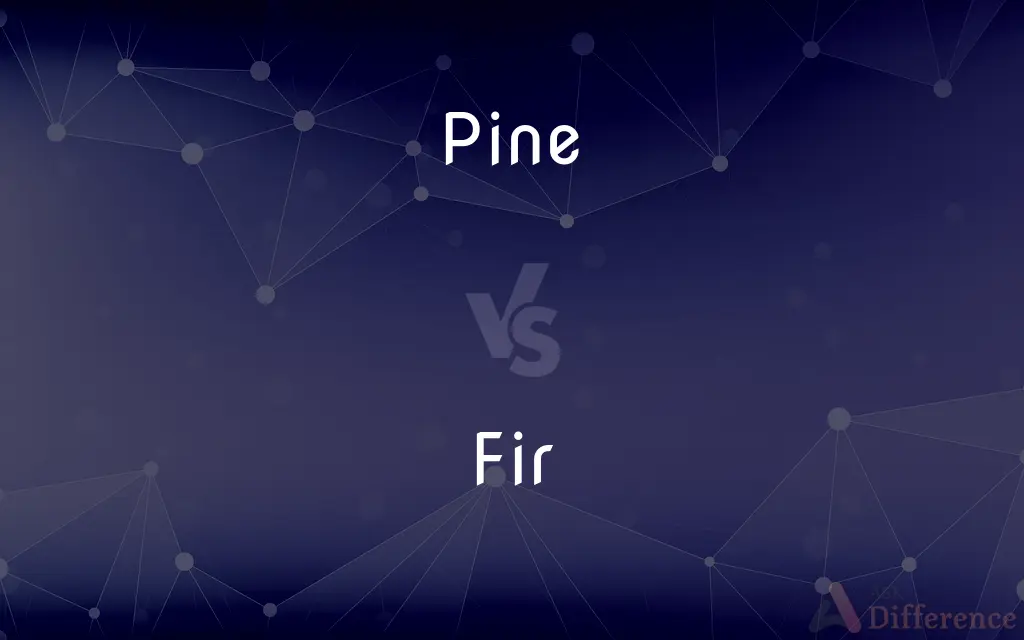Pine vs. Fir — What's the Difference?
Edited by Tayyaba Rehman — By Fiza Rafique — Updated on September 30, 2023
Pines are trees with long needle-like leaves grouped in clusters, while Firs have shorter, singular needles attached directly to branches. Both are coniferous but differ in foliage and cone structure.

Difference Between Pine and Fir
Table of Contents
ADVERTISEMENT
Key Differences
Pines and Firs are both evergreen coniferous trees, but they belong to different genera within the Pinaceae family. Pine trees, belonging to the genus Pinus, are recognized by their long needle-like leaves that come in clusters, known as fascicles. Depending on the species, a Pine may have anywhere from two to five needles in a single cluster. On the other hand, Fir trees, from the genus Abies, exhibit shorter needles that attach individually and directly to the branches, often giving the branches a fuller appearance.
Another distinguishing feature lies in their cones. Pine cones, whether male or female, are typically hard and woody, often taking time to mature. They can hang down or stand upright on branches, with their scales opening to release seeds. Fir cones are different in that they are upright, softer, and tend to disintegrate on the tree once they release their seeds, leaving only the central stalk behind.
Bark texture between Pines and Firs also provides contrast. While Pine bark can vary widely from species to species, it's often flaky or plated. Fir trees usually have smoother bark, which can be quite thin and contains blisters filled with resin in many species.
In summary, while both Pine and Fir trees are essential members of forest ecosystems and are popular in landscaping and timber industries, they can be distinguished by their needle arrangement, cone structures, and bark characteristics.
Comparison Chart
Needles
Long, grouped in clusters (fascicles).
Shorter, singular, attached directly to branches.
ADVERTISEMENT
Cone Orientation
Can be hanging or upright.
Upright and disintegrate on the tree.
Bark Texture
Varies, often flaky or plated.
Smoother, with some species having resin-filled blisters.
Genera
Belongs to the genus Pinus.
Belongs to the genus Abies.
Common Usage
Timber, furniture, pulpwood, and ornamental purposes.
Lumber, plywood, Christmas trees, and ornamental plantings.
Compare with Definitions
Pine
Pine trees are evergreen conifers known for their long needle-like leaves in clusters.
The forest was filled with tall Pine trees swaying in the wind.
Fir
Fir is a popular choice for Christmas trees due to its symmetrical shape and full branches.
Every December, families search for the perfect Fir for their homes.
Pine
Pine is also a type of softwood used in carpentry and construction.
The wooden cabin was primarily built using Pine logs.
Fir
Fir trees are evergreen conifers with short needles attached directly to branches.
The mountain slopes were dotted with Fir trees covered in snow.
Pine
Pines are notable for their distinctive cones used in reproduction.
The ground was littered with Pine cones from the towering trees above.
Fir
The wood from Fir trees is often used in construction and furniture.
The craftsman chose Fir for its durability and smooth finish.
Pine
A pine is any conifer in the genus Pinus () of the family Pinaceae. Pinus is the sole genus in the subfamily Pinoideae.
Fir
Firs have upright cones that disintegrate on the tree after releasing seeds.
Upon closer inspection, only the central stalk of the Fir cone remained.
Pine
An evergreen coniferous tree which has clusters of long needle-shaped leaves. Many kinds are grown for the soft timber, which is widely used for furniture and pulp, or for tar and turpentine.
Fir
Fir trees usually exhibit smoother bark, often with resin-filled blisters in certain species.
The young child was curious about the blisters on the Fir tree's bark.
Pine
A pineapple.
Fir
Firs (Abies) are a genus of 48–56 species of evergreen coniferous trees in the family Pinaceae. They are found through much of North and Central America, Europe, Asia, and North Africa, occurring in mountains over most of the range.
Pine
Suffer a mental and physical decline, especially because of a broken heart
She thinks I am pining away from love
Fir
An evergreen coniferous tree with upright cones and flat needle-shaped leaves, typically arranged in two rows. Firs are an important source of timber and resins.
Pine
Any of various evergreen trees of the genus Pinus, having fascicles of needle-shaped leaves and producing woody seed-bearing cones. These trees are widely cultivated for ornament and shade and for their timber and resinous sap, which yields turpentine and pine tar.
Fir
Any of various evergreen trees of the genus Abies, having linear flattened needles and erect cones with deciduous scales.
Pine
Any of various other coniferous trees, such as the Norfolk Island pine.
Fir
Any of several similar or related trees, such as the Douglas fir.
Pine
The wood of any of these trees.
Fir
The wood of any these trees.
Pine
Intense longing or grief.
Fir
A conifer of the genus Abies.
Pine
To feel a lingering, often nostalgic desire.
Fir
Any pinaceous conifer of related genera, especially a Douglas fir (Pseudotsuga) or a Scots pine (Pinus sylvestris).
Pine
To wither or waste away from longing or grief
Pined away and died.
Fir
(uncountable) Wood of such trees.
Pine
To grieve or mourn for.
Fir
A genus (Abies) of coniferous trees, often of large size and elegant shape, some of them valued for their timber and others for their resin. The species are distinguished as the balsam fir, the silver fir, the red fir, etc. The Scotch fir is a Pinus.
Pine
Any coniferous tree of the genus Pinus.
The northern slopes were covered mainly in pine.
Fir
Nonresinous wood of a fir tree
Pine
(countable) Any tree (usually coniferous) which resembles a member of this genus in some respect.
Fir
Any of various evergreen trees of the genus Abies; chiefly of upland areas
Pine
(uncountable) The wood of this tree.
Pine
A pineapple.
Pine
(archaic) A painful longing.
Pine
(intransitive) To languish; to lose flesh or wear away through distress.
Pine
(intransitive) To long, to yearn so much that it causes suffering.
Laura was pining for Bill all the time he was gone.
Pine
(transitive) To grieve or mourn for.
Pine
(transitive) To inflict pain upon; to torment.
Pine
Woe; torment; pain.
Pine
Any tree of the coniferous genus Pinus. See Pinus.
Pine
The wood of the pine tree.
Pine
A pineapple.
Pine
To inflict pain upon; to torment; to torture; to afflict.
That people that pyned him to death.
One is pined in prison, another tortured on the rack.
Pine
To grieve or mourn for.
Pine
To suffer; to be afflicted.
Pine
To languish; to lose flesh or wear away, under any distress or anexiety of mind; to droop; - often used with away.
Pine
To languish with desire; to waste away with longing for something; - usually followed by for.
For whom, and not for Tybalt, Juliet pined.
Pine
A coniferous tree
Pine
Straight-grained durable and often resinous white to yellowish timber of any of numerous trees of the genus Pinus
Pine
Have a desire for something or someone who is not present;
She ached for a cigarette
I am pining for my lover
Pine
Pine can refer to the act of suffering intense longing or yearning.
After the departure of his friend, he began to Pine for their shared moments.
Pine
In ecology, Pine forests are specific types of ecosystems dominated by these trees.
The Pine forest provided a habitat for various wildlife species.
Common Curiosities
What happens to Fir cones after they release their seeds?
Fir cones disintegrate on the tree, leaving only the central stalk behind.
How are Pine needles typically grouped?
Pine needles are grouped in clusters called fascicles.
What's the general appearance of Fir needles?
Fir needles are shorter, singular, and attach directly to the branches.
Is Pine wood commonly used in construction?
Yes, Pine is a common softwood used in construction, furniture, and pulpwood.
What family do both Pine and Fir belong to?
Both Pine and Fir trees belong to the Pinaceae family.
How do Pine cones typically grow?
Pine cones can be either hanging or upright, depending on the species.
Which type of tree is often used for Christmas?
Fir trees are popular choices for Christmas trees.
Can Pine also refer to a feeling of longing?
Yes, to "Pine for" something means to intensely long or yearn for it.
Which tree typically has resin-filled blisters in its bark?
Many Fir tree species have bark with resin-filled blisters.
Which tree is more commonly found in high altitudes or colder climates?
Fir trees are often found in higher altitudes.
Share Your Discovery

Previous Comparison
Jib vs. Headsail
Next Comparison
Disguise vs. MakeupAuthor Spotlight
Written by
Fiza RafiqueFiza Rafique is a skilled content writer at AskDifference.com, where she meticulously refines and enhances written pieces. Drawing from her vast editorial expertise, Fiza ensures clarity, accuracy, and precision in every article. Passionate about language, she continually seeks to elevate the quality of content for readers worldwide.
Edited by
Tayyaba RehmanTayyaba Rehman is a distinguished writer, currently serving as a primary contributor to askdifference.com. As a researcher in semantics and etymology, Tayyaba's passion for the complexity of languages and their distinctions has found a perfect home on the platform. Tayyaba delves into the intricacies of language, distinguishing between commonly confused words and phrases, thereby providing clarity for readers worldwide.














































